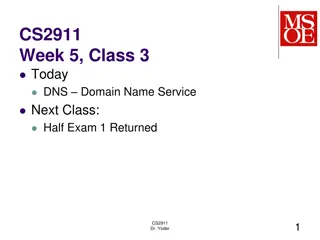
Understanding Email Protocols and Unicode in Python and Java
Learn about the roles of SMTP, IMAP, and POP3 email protocols, as well as the benefits of using UTF-8 encoding for transmitting Unicode characters over the network. Discover how to program an email interface in Python, encode character sets in internet messages, and more.
Download Presentation

Please find below an Image/Link to download the presentation.
The content on the website is provided AS IS for your information and personal use only. It may not be sold, licensed, or shared on other websites without obtaining consent from the author. If you encounter any issues during the download, it is possible that the publisher has removed the file from their server.
You are allowed to download the files provided on this website for personal or commercial use, subject to the condition that they are used lawfully. All files are the property of their respective owners.
The content on the website is provided AS IS for your information and personal use only. It may not be sold, licensed, or shared on other websites without obtaining consent from the author.
E N D
Presentation Transcript
CS2911 Week 6, Class 1 Today Sit by someone you don't know again! Return half exam 1 Review Muddiest Point Email & SMTP Muddiest Point This week, Lab: Quiz at start of lab Week 7, Monday: Half-Exam 2 CS2911 Dr. Yoder 1
Quiz Outcomes ~ 80%: Write code to interpret a simple custom protocol ~ 20% Outcomes for Half Exam 1 perhaps difficult outcomes on the exam or outcomes not included in the exam CS2911 Dr. Yoder 2
Outcomes Describe the roles of the SMTP, IMAP, and POP3 email protocols Describe the operation of the SMTP protocol Explain how SMTP and IMAP are used, and the server configuration used in contemporary email settings Describe the differences between POP3 and IMAP 3
Outcomes Describe the operation of the IMAP protocol at a high level Describe how character sets are encoded in in internet messages (Lab 7) Program an email interface in Python 4
Muddiest Point 5-2 Has there ever been a push to renumbered characters in the order that they are used?(ie: the most commonly used character would be represented as 0x01) [Beyond scope] I've been having trouble finding a way to generate unicode characters in python and java Your explanation why utf-8 is useful for sending fewer bits over the network cleared it up for me. Thanks. Compressin g Unicode Generating Unicode in Code Fewer bits with UTF-8? 5
Muddiest Point 5-2 what happens if you try to send a unicode character to something reading utf-8? [Mojibake google it] Aren't the percent-hex encodings just the the hex representations of the code points in their normal order? [Not yet covered] What is the point of UTF-8 if the unicode characters end up taking more bytes to store? Mixing encodings Percent-hex Fewer bits with UTF-8? 6
Introduction to Python Python ages = dict() OR ages = {} ages["Nancy"] = 5 ages["Bob"] = 10 print "B:",ages["Bob"] for item in ages.items(): print item[0]+": "+str(item[1]) Java Map<String,Integer> ages = new HashMap<>(); ages.put("Nancy", 5); ages.put("Bob", 10); S.o.pl("B: "+ages.get("Bob")); for(Map.Entry<String,Integer> e: ages.entrySet()) { S.o.pl(e.getKey()+": " +e.getValue()); } SE-2811 Dr. Yoder 7
Dictionaries A Python Dictionary is like a Map in Java You can use an object as an "index" for an item. The index object is called a "key" and the object stored is called a "value" You can use any object they don't have to be integers, and they aren't stored sequentially in memory You can iterate through all the entries in a dictionary, or look up an item by its key SE-2811 Dr. Yoder 8
Some important methods items() returns a list of all keys and values, where each item is a tuple holding (key, value) keys() returns a list of all keys values() returns a list of all values k in my_dict returns true if the value is stored in the dictionary my_dict SE-2811 Dr.Yoder 9
Questions on Lab 6? Dictionaries? Writing the code? Excellent credit? Persistent connections? Implementing caching? CS2911 Dr. Yoder 10
Unencrypted SMTP without Authentication S: 220 aol.com Simple Mail Transfer Service Ready C: EHLO msoe.edu S: 250-aol.com greets msoe.edu S: 250-8BITMIME S: 250-SIZE S: 250-DSN S: 250 HELP C: MAIL FROM: <smith@msoe.edu> S: 250 OK SE-2811 Dr.Yoder 11
Unencrypted SMTP without Authentication (cont.) C: RCPT TO: <jones@aol.com> S: 250 OK C: RCPT TO: <frank@aol.com> S: 550 No such user here C: DATA S: 354 Start email input; end with <CRLF>.<CRLF> C: Here's my message C: It's a long one C: Now I'm done. But does the server know it? C: . S: 250 OK C: QUIT S: 221 aol.com Service closing transmission channel SE-2811 Dr.Yoder 12
Looking Forward Cryptography Videos: (From Week 9) Cryptography in network protocols Public key cryptography Modular arithmetic RSA encryption Encryption: Plaintext -> Ciphertext Decryption: Ciphertext -> Plaintext Both require a "key" SE-2811 Dr.Yoder 13
SMTP with STARTTLS and AUTH LOGIN (1) S: 220 aol.com ESMTP MAIL Service ready C: EHLO msoe.edu S: 250-aol.com Hello [10.10.10.10] S: 250-PIPELINING S: 250-DSN S: 250-ENHANCEDSTATUSCODES S: 250-STARTTLS S: 250-8BITMIME S: 250 CHUNKING SE-2811 Dr.Yoder 14
SMTP with STARTTLS and AUTH LOGIN (2) C: STARTTLS S: 220 2.0.0 SMTP server ready ---- Everything beyond this point is sent encrypted ---- C: EHLO msoe.edu S: 250-aol.com Hello [10.10.10.10] S: 250-PIPELINING S: 250-DSN S: 250-ENHANCEDSTATUSCODES S: 250-AUTH LOGIN S: 250-8BITMIME S: 250 CHUNKING SE-2811 Dr.Yoder 15
SMTP with STARTTLS with AUTH LOGIN (3) "Username:" C: AUTH LOGIN S: 334 VXN1cm5hbWU6 C: c3R1ZGVudEBtc291LmVkdQ== S: 334 UGFzc3dvcmQ6 C: bW9ua2V5 S: 235 2.7.0 Authentication successful C: MAIL FROM: <student@msoe.edu> (The rest is the same as unencrypted) "student@msoe.edu" "Password:" "monkey" SE-2811 Dr.Yoder 16
Base64 encoding https://tools.ietf.org/html/rfc4648#section-4 Use the base64 package, already imported in the lab template. Use RFC 4648 base-64 encoding, as specified in the latest AUTH LOGIN RFC, RFC 4954. This is the same as the base-64 encoding defined in RFC 3548. SE-2811 Dr.Yoder 17
Sending/Receiving Encrypted Data in Python context = ssl.create_default_context() wrapped_socket = context.wrap_socket(old_socket, server_hostname=SMTP_SERVER) SE-2811 Dr.Yoder 18
Sending/Receiving Encrypted Data in Python Some errors if you accidentally receive/send raw/encrypted text when you should send the other: ssl.SSLZeroReturnError: TLS/SSL connection has been closed (EOF) (_ssl.c:590) ssl.SSLError: [SSL: UNKNOWN_PROTOCOL] unknown protocol (_ssl.c:590) ssl.SSLError: [SSL: WRONG_VERSION_NUMBER] wrong version number (_ssl.c:590) SE-2811 Dr.Yoder 19
Sending/Receiving Encrypted Data in Python Some errors if you use the wrong protocol (which is hard to do with our sample code) ssl.SSLZeroReturnError: TLS/SSL connection has been closed (EOF) (_ssl.c:590) ssl.SSLEOFError: EOF occurred in violation of protocol (_ssl.c:590) SE-2811 Dr.Yoder 20
17q1: TODO Need to go over email format headers as well CS2911 Dr. Yoder 21
Acknowledgement This course is based on the text Computer Networking: A Top Down Approach 7th edition Jim Kurose, Keith Ross Addison-Wesley 23

